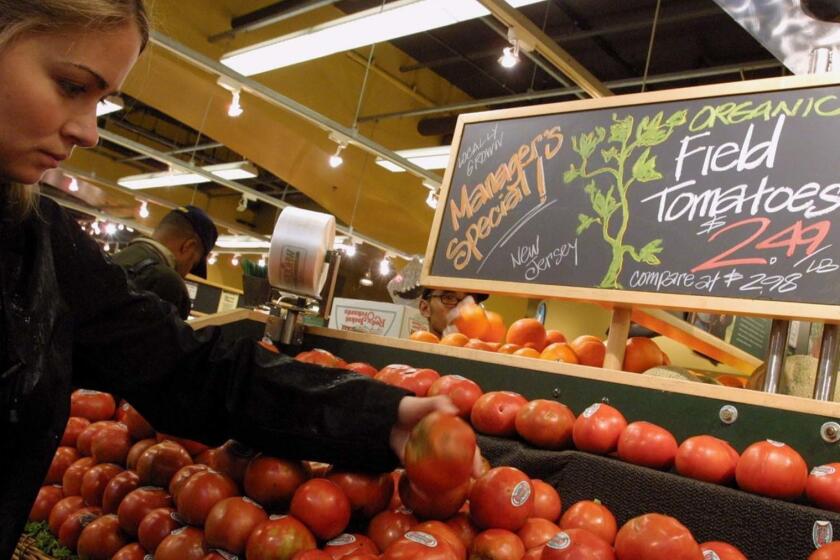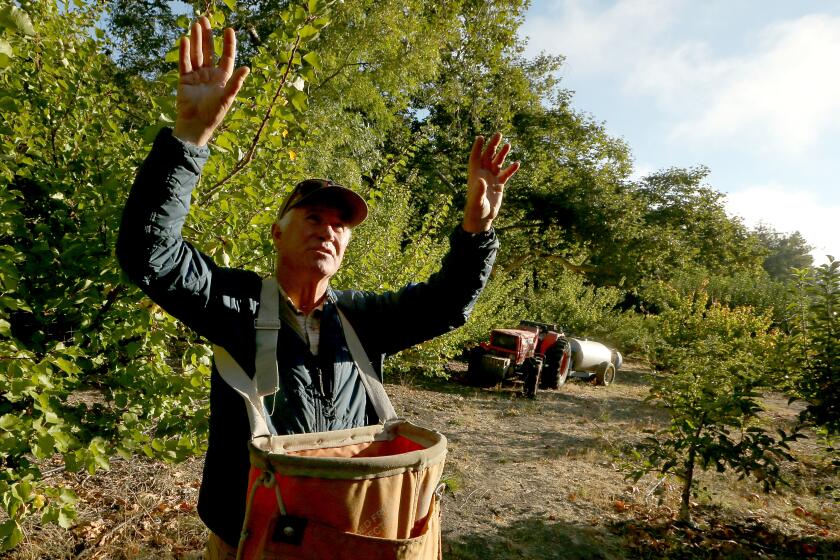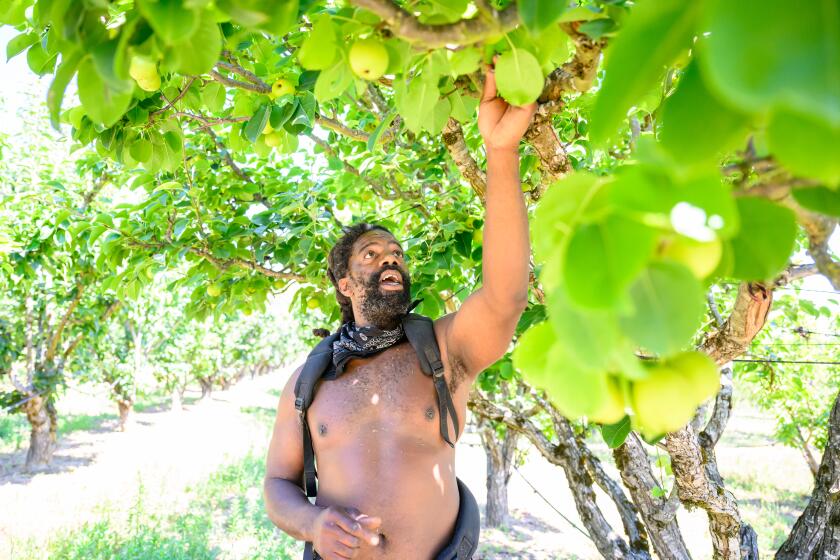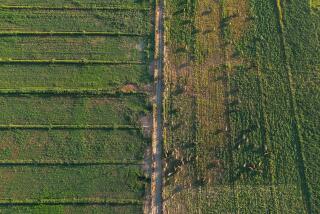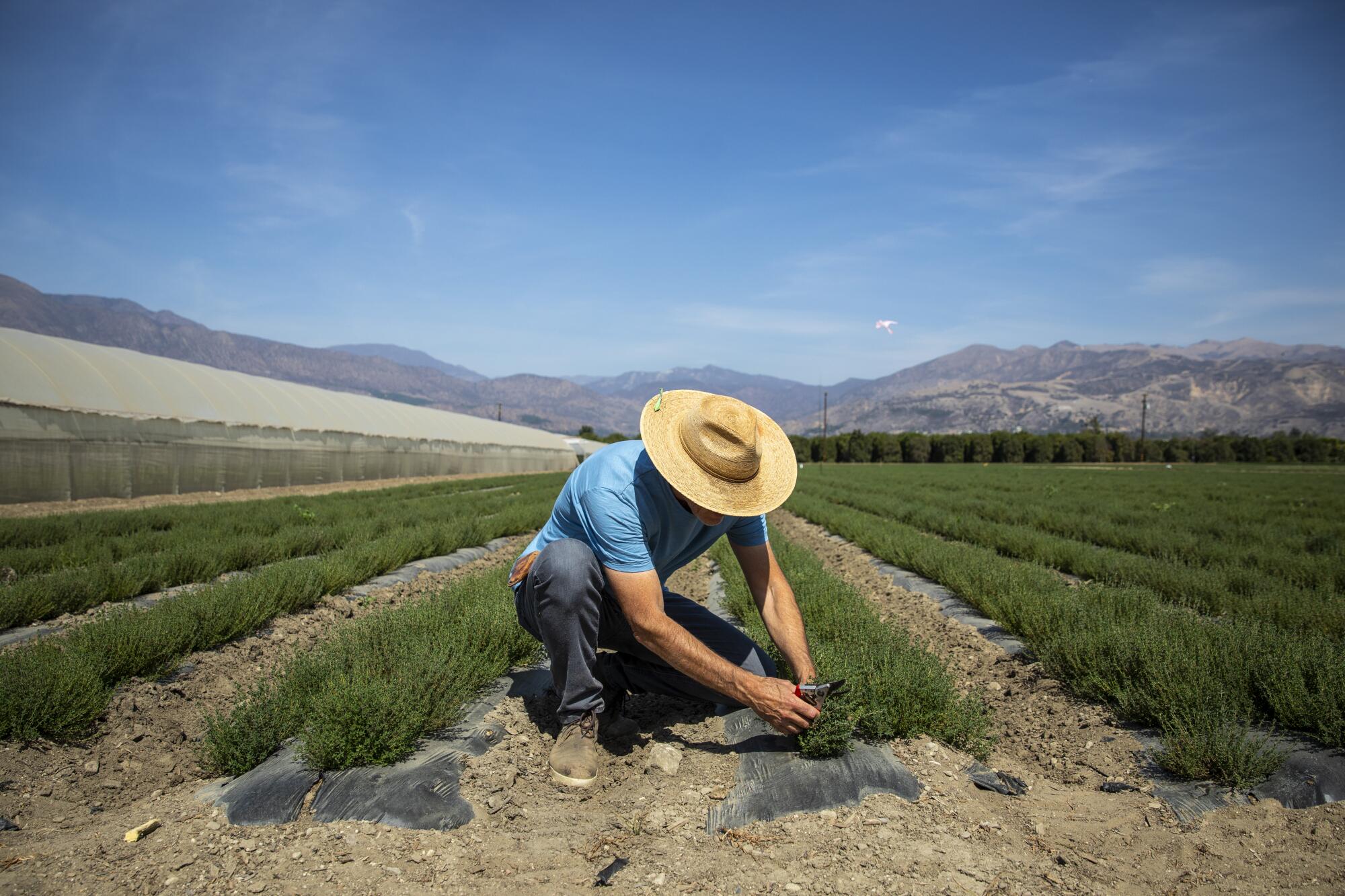
- Share via
To help California fight climate change, air quality regulators would like to see 20% of the state’s farmland go organic by 2045. That means converting about 65,000 acres of conventional fields to organic practices every year.
But depending on how that transition happens, the change could lead to an overall increase in the amount of pesticide used by growers throughout the state.
So suggests a new study in the journal Science that examined how organic farms influence the behavior of their neighbors. Researchers found that when new organic fields come online, the insects that come with them may prompt conventional growers to boost their pesticide use by an amount large enough to offset the reduction in organic fields — and then some.
“We expect an increase in organic in the future,” said study leader Ashley Larsen, a professor of agricultural and landscape ecology at UC Santa Barbara. “How do we make sure this is not causing unintended harm?”
Organic farming practices help fight climate change by producing healthier soil that can hold on to more carbon and by eschewing synthetic nitrogen fertilizers, which fuel greenhouse gas emissions. Organic methods are also more sustainable for a warming world because they help the soil hold more water, among other benefits.
To reduce your risk of cancer, you know you should quit smoking, exercise regularly, wear sunscreen, and take advantage of screening tests.
For their study, Larsen and her colleagues took a deep dive into the farming practices of California’s Kern County, where growers regularly produce more than $7 billion worth of grapes, citrus, almonds, pistachios and other crops. Thanks to the county and the state, there are detailed records going back for years about just how they do it.
The researchers examined about 14,000 individual fields between 2013 and 2019. They were able to see the shapes and locations of these fields, as well as whether they were growing conventional or organic crops and how much pesticide was used.
Indeed, a key difference between conventional and organic agriculture is their approach to dealing with unwanted pests. Traditional farms may deploy toxic chemicals like organophosphates and organochlorines, while organic farms prefer to keep damaging bugs in check by encouraging the growth of their natural enemies, including particular beetles, spiders and birds. They can also use certain pesticides, which typically are made with with natural instead of synthetic ingredients.
These contrasting strategies make for complicated neighbors. If destructive critters migrate from an organic farm to a conventional one, a grower may respond by using more pesticide. That, in turn, would undermine the helpful creatures organic growers rely upon. On the other hand, organic farms nurture beneficial insects that migrate to other fields.
“Organic farms can be both a blessing and a curse if they’re your neighbor,” said David Haviland, an entomologist with the University of California’s integrative pest management program in Bakersfield, who was not involved in the study.
By 2019, about 7.5% of permitted fields in Kern County were used to grow organic products. They were distributed throughout the county’s growing areas, though many were grouped into clusters.

With their data in hand, the researchers created a statistical model to see if they could find a relationship between pesticide use in a given field and the presence of organic fields nearby.
In the case of organic fields, they found that a 10% increase in neighboring organic cropland was associated with a 3% decline in pesticide use. For conventional fields, the same 10% bump in organic neighbors came with a 0.3% rise in pesticide use.
Since conventional fields outnumbered organic ones by a wide margin, the net effect in Kern County was a 0.2% increase in pesticide use. Most of that was driven by added insecticides rather than chemicals that targeted invasive weeds or damaging fungi, Larsen said.
“We think it basically comes down to a different reliance on natural pest-control methods,” she said. More bugs are bad for conventional farmers because for them it means more unwanted insects, she explained. But more bugs are good for organic farmers because it means having more natural enemies of those same pests.
Despite health concerns, paraquat continues to be a popular herbicide in California and other parts of the United States. Some hope to see it banned.
The researchers also used their model to simulate different possible farming futures to see if this overall increase in pesticide use could be avoided. The answer, they found, was yes.
One way was to expand the amount of land farmed organically. In their model, going from no organic fields at all to 5% of cropland being organic was associated with a 9% hike in insecticide use in Kern County. However, if 20% of agricultural land held organic crops — as the California Air Resources Board envisions — total insecticide use fell by 17%.
Those figures were based on a simulation in which organic fields were spread out, maximizing the pest-control border skirmishes between organic and conventional fields. In a scenario where organic fields were clustered together instead, increasing their combined footprint from 0% to 5% of total acreage was associated with a 10% cut in insecticide use, and going all the way to 20% of total acreage was linked with a 36% drop in the chemicals, the researchers reported.
“What we basically see in the simulation is that while there could be an increase in insecticide use at low levels of organic, it can be entirely mitigated by spatially clustering organic croplands,” Larsen said.
Making that happen in a simulation is one thing; doing it in the real world is another. An organic almond farmer whose orchard abuts a conventional one can’t easily dig up his mature trees and replant them somewhere else. But as farmers switch more of their conventional fields to organic, these study results could help them decide where to focus their efforts to get the biggest payoff, Larsen said.
Likewise, policymakers might identify certain areas where they’d like to see organic crops and offer incentives to encourage growers to make the leap. In principle, it would be similar to the grants offered by the California Department of Food and Agriculture’s Healthy Soils Program, she said.
Some California growers specialize in dry farming, working with nature to grow apples and melons without irrigation. They tout the approach as a water solution.
Erik Lichtenberg, an agricultural economist at the University of Maryland, said the study made “a convincing case” that organic farms affect their neighbors, but it would be important to know a lot more specifics before concluding that it’s a good idea to segregate organic and conventional farms.
Among other things, “I would want to know more about why the fields are located the way they are, what you plant where, and how that relates to the pest-management strategies the growers are following,” said Lichtenberg, who wrote a a commentary that accompanies the study.
Haviland said the idea of clustering organic farms makes sense in general because it reduces the edges between organic and conventional fields. However, he noted that there are instances where clustering could make things worse.
Consider the glassy-winged sharpshooter, which spreads a disease that kills grapevines. Conventional farmers have tools at their disposal to control them, but organic growers do not. When organic grapevines are more isolated, the chances that an insect flies away from the field and “doesn’t come home” are greater because it will encounter a pesticide nearby, Haviland said. But if all the organic fields were clustered together, they’d be “drastically increasing their own problem by not benefiting from conventional growers around them.”
Haviland also emphasized that “there’s a misconception among the general public that all pesticides are created equal and they’re all bad, and that’s definitely not true.” Reducing total pesticide use is valuable, but it’s more important to consider the types of pesticides being used, he said.
Inspired by Octavia Butler’s Afrofuturist fiction, a Sonoma County farmer helps Black Californians connect with nature and learn lessons in climate resilience.
The statistical analysis alone doesn’t prove that the addition of organic fields is responsible for the change in pesticide use, but Larsen said the circumstantial evidence for a causal relationship is compelling. The conventional fields that acquired an organic neighbor used to have the same pattern of pesticide use as their fellow other conventional fields, and they started to diverge only after the nearby field switched to organic.
“This is pretty strong evidence, in our minds,” she said.
Milt McGiffen, a cooperative extension specialist with the Department of Botany and Plant Sciences at UC Riverside, was less sure. He said growers make a point of planting organic crops in places where they know pest control won’t be a big problem since they can’t use conventional pesticides.
“Mostly why you have have a group of organic farms together is because that’s where you have the fewest pests, not the other way around,” said McGiffen, who wasn’t involved in the study.
He said there are many examples of governments trying to accelerate the transition to organic food production, but he is not aware of any effort to encourage growers to locate organic fields in specific places.
“This study has interesting ideas,” McGiffen said, but “some experimentalist needs to go out there and test all this.”
